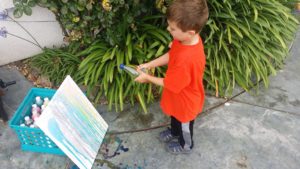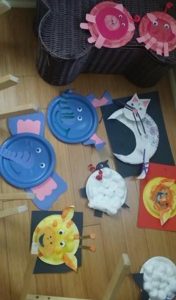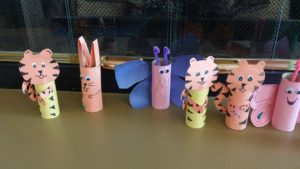Spirited Children
Not all children are the same. Some are easygoing and others are more challenging because they are strong-willed, easily frustrated, very active, have very intense emotions, and/or have trouble with changes, transitions or situations that are new.
Learning about temperament can help you understand and work more effectively with children. Temperament is each person’s natural inborn style of interaction that we use to influence and respond to the world around us.
Temperament
Temperament describes how a child reacts, not why she reacts in a particular way. Remembering that temperamental styles are part of the child’s nature helps us to better understand the child’s experience. And that in turn helps us to respond constructively to the child’s strengths and needs.
Who Coined The Term “Spirited Children”?
In 1965, Dr. Alexander Thomas, Stella Chess, and Herbert Birch conducted New York Longitudinal Study. 133 children were observed from infancy into adulthood. Their main aim was to identify various characteristics of these children as they grow into adults. Their study revealed nine traits or characteristics. These different behavioral patterns are present in every person in different intensity. However, spirited children tend to exhibit intense characteristics .
Who is the “Spirited Child”?
All toddlers are busy, but the spirited child is much busier. If you care for a spirited child you will have more on your hands. While a high-energy child is typical, spirited children are more intense, persistent and empathetic than others.
Identifying a Spirited Children
Likes to perform–
She may be charming, and among her peers she may be recognized as a charismatic leader. She may seem always hungry for attention and loves being the center of attention. She may feed on external stimulation including needing feedback from others.
Insatiable-
He often demands immediate responses from you, and sometimes whatever you do, it does not seem to satisfy him.
High energy level–
She may be physically active, always exploring, and unable to slow herself down without help. She may be restless, fidgety, constantly on the move. She may have no sense of what is
appropriate behavior and may not follow rules.
Has a hard time adapting–
Fearful of new situations, he may cling to you. He may need extra time to make
transitions to new routines or activities. He may be shy and reserved when meeting new people. He may “lock in” to important ideas, and may love to debate.
Intelligent–
She is often bright, even gifted. She is creative and frequently a keen observer.
Needs less sleep–
He may wake up often at night and may not take a nap during the daytime. He may not keep to a regular schedule for sleeping.
Extra sensitive–
If usually sensitive to sights, sounds, smells, tastes and skin sensations, she may be quickly and easily over-stimulated by what is going on around her. She may hate to be confined physically.
Demanding–
He often needs your attention constantly. He usually has very strong preferences in most matters.
Emotionally intense-
.Everything is black or white, happy or sad—there is no middle ground in her choices, opinions or life in general. As an infant, she cried more than others. She is usually loud and forceful whether miserable, happy or angry.
Developmental Stages and Characteristics of Spirited Children
What Are the Characteristics of Spirited Babies?
A spirited child often displays the following characteristics:
- Have to be held constantly and demands a lot of attention during day and night-time
- Do not have proper schedule of eating or toilet habits
- Have a tendency to cry without any cause
- Strongly react when forced to sleep.
What Are the Characteristics of Spirited Toddlers?
When a spirited child starts going to school some difficult traits get intensified while some disappear permanently. Common traits include:
- Gets bored easily
- Wants to stay attached to parents, separation anxiety common
- Often a picky eater
- Wakes up unhappy
- Mood swings or cranky behavior
- Violent, intense tantrums that may last for several hours
- Active during play and sleep
- Prefers to follow regular routine
- Very determined and self-directed
- May dislike clothing blends
- May display temper tantrums
- Wants to do everything themselves
- Often scream, vomit, hit or bang their head without purpose.
What Are the Characteristics of Spirited School Aged Child?
- Very structured and needs routines
- Better tempered if the child gets adequate sleep and food
- Very determined in needs and wants. Still is very self directed
- May dislike clothing blends
- Requires a lot of physical contact
- May still have temper tantrums if goals are thwarted
- May still have periods of separation anxiety
What Are the Characteristics of Spirited Teenagers?
When a spirited child grows into a teenager, he or she often displays the following traits:
- Do not get swayed away by peers
- Self directed
- May require lot of physical contact
- Prefers to make own decisions
- Can take own responsibility for ensuring proper food intake and adequate sleep.
Working with the spirited child
Provide quality time–
Though the child may be gaining some independence, it is best to maintain
a day-to-day special time with just him. Find a favorite song or book that both of you enjoy together daily. This establishes a trust that you will always be there, focusing on the development of a meaningful adult-child relationship.
Keep them informed–
When you explain to a child what she should expect, it defuses anxiety about what
is coming. For example, offer advanced notice when an activity is about to end. “When we finish reading this book, we’re going to wash our hands and get ready for lunch.” Prepare and support the child for major and minor changes in the daily routine. Allow a little extra time for this child to move from one activity to another.
Be consistent–
High-spirited children need rules and limits. Express expectations simply and directly. And once you set the rules, stick to them by creating a predictable plan for activities, mealtimes, naptimes, etc. and adhere to it as much as possible.
Anticipate–
If a high-spirited child acts up in certain places or situations, make other arrangements or adjustments. Acknowledge his reality and show you understand by validating his feelings, which helps to protect his sense of autonomy. “I know it’s hard for you to be in crowded, noisy places. I know that it can be overwhelming.” Offer physical comfort when he is distressed. Try giving him a big hug or massaging his back.
Offer praise–
Positive reinforcement offers encouragement and raises a child’s self-esteem. When she sits through and finishes her lunch without getting distracted, let her know that you are pleased with her progress.
Be specific– Instead of saying “good girl,” share with her exactly what you are delighted about, such as “I like the way you were able to eat your lunch with your friends today.”
Let them help–
When a child wants to start doing things for himself, let him. It may take a few extra minutes or become messy, but it will probably prevent tantrums and power struggles, and it will promote self-mastery. For example, let him put on his own shoes, or set the table for dinner.
Avoid labels-
Be careful how you describe a child. Labels have a tendency to stick and affect a child’s self-esteem. Focus on the child’s positive attributes, her strengths and competencies, rather than her difficulties and weaknesses. Instead of saying, “Jaime is so stubborn and bad,” try “Jaime knows what she likes and is energetic.”
Respect their pace and style–
Do not punish him for who he is.
He is not over reacting…he just needs help to express his strong feelings in a more appropriate manner. Proactively teach and model acceptable expressions of anger, sadness, fear and frustration.
All behavior has meaning–
Specific behaviors may mean different things to different people, but they mean something. We must appreciate that a child’s behavior and style are a combination of many things: age, personality, temperament, cultural roots, family traditions and expectations, experience, etc. And we may not always get it right, but it is important to understand your perception of the child’s behavior and temperament. It is not about changing the child; rather you must seek ways to accommodate in order to meet the child’s individual needs.

















